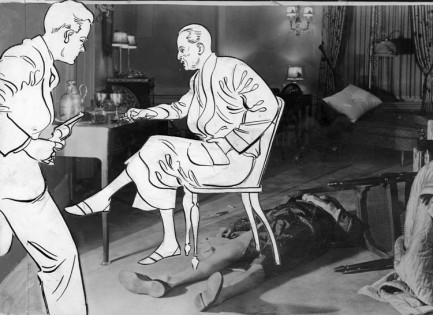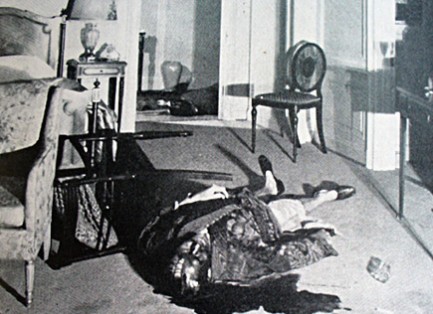| The Naked City | Feb 16 2016 |

Embarrassing family scandal ends in murder.

 The above crime scene drawing shows murder victim Ned Doheny, Jr. in the bedroom of his Los Angeles mansion after being killed by a gunshot to the head, along with a superimposition of where police imagine he was just before he was shot. From the above angle the event looks clinical, but a reverse view reveals an unholy mess, with Doheny's face and robe drenched in blood, and a dark pool spread across the carpet.
The above crime scene drawing shows murder victim Ned Doheny, Jr. in the bedroom of his Los Angeles mansion after being killed by a gunshot to the head, along with a superimposition of where police imagine he was just before he was shot. From the above angle the event looks clinical, but a reverse view reveals an unholy mess, with Doheny's face and robe drenched in blood, and a dark pool spread across the carpet.Out of sight in the hall leading to the bedroom is the body of Hugh Plunkett, Doheny's presumed murderer, dead from a self-inflicted gunshot wound. For a time this was the most famous crime in L.A. history. Doheny was the son of oil tycoon E.L Doheny, who was in trouble for passing bribes to U.S. Secretary of the Interior Albert Fall. The investigation and legal circus, known as the Teapot Dome scandal, had ensnared not just the senior Doheny but Doheny Jr. and Plunkett. They had both been indicted for conveying the dirty money from Doheny Sr. to Secretary Fall.
Realistically speaking, there was no serious threat of the Dohenys going to jail. But working class Hugh Plunkett was not a tycoon nor a tycoon's son, which meant for him the possibility of incarceration was real. When Jr. was offered immunity and Plunkett was not, their close friendship began to fray. Plunkett's growing instability spawned attempts to get him into a mental facility—whether to save his mind or save him from testifying remains a subject of debate—but it never happend. Today in 1929 he visited the Doheny mansion to talk with his pal Ned and hours later the result is what you see in the crime scene photos.
in 1929 he visited the Doheny mansion to talk with his pal Ned and hours later the result is what you see in the crime scene photos.
 in 1929 he visited the Doheny mansion to talk with his pal Ned and hours later the result is what you see in the crime scene photos.
in 1929 he visited the Doheny mansion to talk with his pal Ned and hours later the result is what you see in the crime scene photos.There's much more to the case—rumors of a sexual relationship between Doheny Jr. and Plunkett, rumors that Doheny Sr. pulled the trigger on both men, etc.—but we'll leave all that aside. The truly interested can find at least a dozen websites that dig into every aspect of the case. We just wanted to show you the photo-illustration, which is yet another police photo from the University of Southern California digital archive.




































































